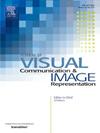用于视觉跟踪的学习干扰抑制响应变差感知多正则化相关滤波器
IF 2.6
4区 计算机科学
Q2 COMPUTER SCIENCE, INFORMATION SYSTEMS
Journal of Visual Communication and Image Representation
Pub Date : 2025-04-17
DOI:10.1016/j.jvcir.2025.104458
引用次数: 0
摘要
判别相关滤波器以其较高的精度和计算效率在目标跟踪中得到了广泛的应用。然而,传统的DCF方法仅依赖于连续帧,由于时间信息有限,往往缺乏鲁棒性,并且可能受到历史帧引入的噪声的影响。为了解决这些限制,我们提出了一种新的干扰抑制响应变化感知多正则化跟踪(DSRVMRT)方法。这种方法通过在过滤器训练中加入历史间隔信息来提高跟踪稳定性,从而利用更广泛的时间上下文。我们的方法包括响应偏差正则化以保持一致的响应质量,并引入接收信道权重分布以提高信道可靠性。此外,我们使用响应桶实现干扰感知方案,该方案检测和惩罚受类似物体或部分遮挡影响的区域,减少跟踪中断。对公共跟踪基准的广泛评估表明,与现有方法相比,DSRVMRT具有更高的准确性、鲁棒性和有效性。本文章由计算机程序翻译,如有差异,请以英文原文为准。
Learning disruptor-suppressed response variation-aware multi-regularized correlation filter for visual tracking
Discriminative correlation filters (DCF) are widely used in object tracking for their high accuracy and computational efficiency. However, conventional DCF methods, which rely only on consecutive frames, often lack robustness due to limited temporal information and can suffer from noise introduced by historical frames. To address these limitations, we propose a novel disruptor-suppressed response variation-aware multi-regularized tracking (DSRVMRT) method. This approach improves tracking stability by incorporating historical interval information in filter training, thus leveraging a broader temporal context. Our method includes response deviation regularization to maintain consistent response quality and introduces a receptive channel weight distribution to enhance channel reliability. Additionally, we implement a disruptor-aware scheme using response bucketing, which detects and penalizes areas affected by similar objects or partial occlusions, reducing tracking disruptions. Extensive evaluations on public tracking benchmarks demonstrate that DSRVMRT achieves superior accuracy, robustness, and effectiveness compared to existing methods.
求助全文
通过发布文献求助,成功后即可免费获取论文全文。
去求助
来源期刊

Journal of Visual Communication and Image Representation
工程技术-计算机:软件工程
CiteScore
5.40
自引率
11.50%
发文量
188
审稿时长
9.9 months
期刊介绍:
The Journal of Visual Communication and Image Representation publishes papers on state-of-the-art visual communication and image representation, with emphasis on novel technologies and theoretical work in this multidisciplinary area of pure and applied research. The field of visual communication and image representation is considered in its broadest sense and covers both digital and analog aspects as well as processing and communication in biological visual systems.
 求助内容:
求助内容: 应助结果提醒方式:
应助结果提醒方式:


